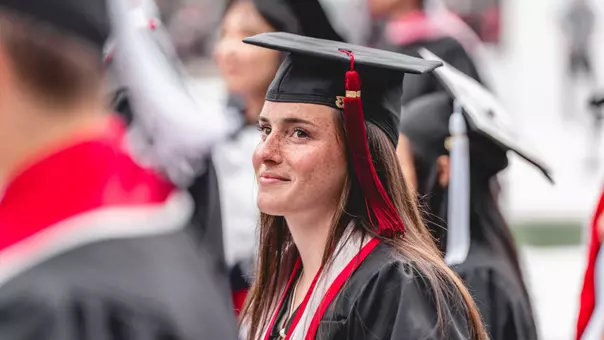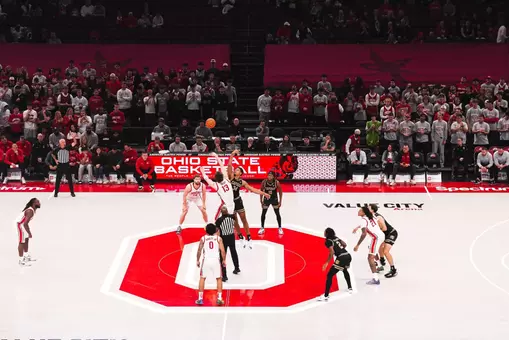
Ohio State Awarded 2024 Ohio EPA Recycle Ohio Grant to Advance Ohio Stadium Zero Waste Efforts
3/20/2025 1:42:00 PM | General
COLUMBUS, Ohio – The Ohio State University has been awarded the Ohio Environmental Protection Agency (EPA) 2024 Recycle Ohio Grant to support the Post-Consumer Waste Bin Transition Project at Ohio Stadium, furthering the university's commitment to sustainability and waste diversion. The grant enabled Ohio State to upgrade 20 waste stations in the club levels, transitioning from a two-bin (recycle/compost) system to a three-bin (trash/recycle/compost) system.
The installation of these new three-bin stations enhances waste sorting by providing clear distinctions between trash, recyclables, and compostable materials. Consistent, visually aligned signage across all waste stations ensures that event attendees and staff correctly dispose of waste, reinforcing Ohio State's Zero Waste goals. Zero Waste Interns play a key role in the initiative, conducting periodic waste audits to measure effectiveness, track contamination levels, and identify areas for improvement.
This initiative, made possible through the support of the Ohio EPA, Ohio State Athletics, and Ohio State Facilities Operation and Development, aims to enhance waste diversion rates during non-football events, supporting Ohio State's long-term commitment to divert 90% of waste from landfills as part of the university's zero waste goal.
Since the installation of the three-bin system in August, waste audits have shown significant progress, with recycling capture rates increasing by 20% and contamination rates decreasing by 25%. This means more recyclables are correctly sorted, while fewer non-recyclable items end up in the recycling and compost bins. As a result, waste streams are cleaner, improving diversion efforts and reducing landfill waste.
"These numbers are encouraging, especially considering they have been achieved without an extensive educational push," Logan Gould, Ohio State's Zero Waste Coordinator, said. "Looking ahead, we'll focus on expanding education and outreach to reduce contamination even further and help visitors make informed choices about what goes in each waste stream."
Colin Thompson, Ohio State's Sr. Associate Athletic Director of Facilities and Events, emphasized the importance of this transition in improving stadium sustainability efforts. "The success of the three-bin system demonstrates Ohio State's commitment to leading in sustainable waste management," Thompson said. "These improvements not only enhance waste diversion but also create a model that can be expanded to other areas of the stadium and campus in the future."
The university continues to take key steps in sustainable waste management. The success of this project serves as a model for expanding efforts to additional areas, further advancing waste diversion efforts at Ohio Stadium and beyond. Ohio State sincerely thanks the Ohio EPA for its generous funding and continued support in advancing sustainability initiatives.
For more information on Ohio State's sustainability initiatives, visit Ohio State Buckeyes Sustainability.
The installation of these new three-bin stations enhances waste sorting by providing clear distinctions between trash, recyclables, and compostable materials. Consistent, visually aligned signage across all waste stations ensures that event attendees and staff correctly dispose of waste, reinforcing Ohio State's Zero Waste goals. Zero Waste Interns play a key role in the initiative, conducting periodic waste audits to measure effectiveness, track contamination levels, and identify areas for improvement.
This initiative, made possible through the support of the Ohio EPA, Ohio State Athletics, and Ohio State Facilities Operation and Development, aims to enhance waste diversion rates during non-football events, supporting Ohio State's long-term commitment to divert 90% of waste from landfills as part of the university's zero waste goal.
Since the installation of the three-bin system in August, waste audits have shown significant progress, with recycling capture rates increasing by 20% and contamination rates decreasing by 25%. This means more recyclables are correctly sorted, while fewer non-recyclable items end up in the recycling and compost bins. As a result, waste streams are cleaner, improving diversion efforts and reducing landfill waste.
"These numbers are encouraging, especially considering they have been achieved without an extensive educational push," Logan Gould, Ohio State's Zero Waste Coordinator, said. "Looking ahead, we'll focus on expanding education and outreach to reduce contamination even further and help visitors make informed choices about what goes in each waste stream."
Colin Thompson, Ohio State's Sr. Associate Athletic Director of Facilities and Events, emphasized the importance of this transition in improving stadium sustainability efforts. "The success of the three-bin system demonstrates Ohio State's commitment to leading in sustainable waste management," Thompson said. "These improvements not only enhance waste diversion but also create a model that can be expanded to other areas of the stadium and campus in the future."
The university continues to take key steps in sustainable waste management. The success of this project serves as a model for expanding efforts to additional areas, further advancing waste diversion efforts at Ohio Stadium and beyond. Ohio State sincerely thanks the Ohio EPA for its generous funding and continued support in advancing sustainability initiatives.
For more information on Ohio State's sustainability initiatives, visit Ohio State Buckeyes Sustainability.
No videos available.







